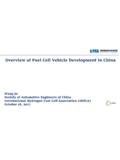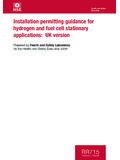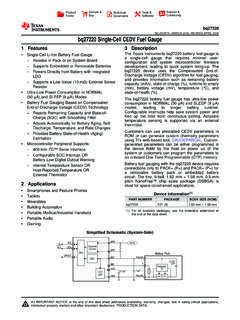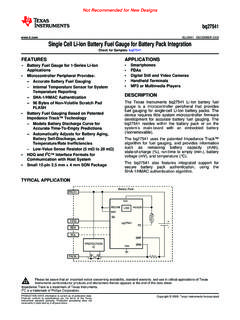Transcription of Chapter Three The hydrogen fuel cell power system
1 83~ Chapter ThreeThe hydrogen fuel cellpower system ~84 This Chapter discusses two major issues: (i) fuel cell theory and engineering, and (ii) providing fuelfor the fuel cell. The first section thoroughly discusses the science behind fuel cells in general. Of the different kindsof fuel cells , the proton exchange membrane type is identified as the unquestioned best candidatefor the small vehicle application. Engineering issues like how to cool the fuel cell stack and whetherto pressurize the fuel cell are discussed in general terms and the feasibility of certain design optionsis determined. (On the other hand, more complete, quantitative analyses of cooling andpressurization require more detailed information about steady-state and transient powerrequirements that are not calculated until Chapter 4, and are thus properly analyzed within thatchapter).
2 The size and weight of the fuel cell are discussed with reference to previous researchers second half of this Chapter concerns fueling of hydrogen fuel cells , which is considerably morecomplex than filling a tank with gasoline. It explains why reformed fossil fuels cannot yet be usedto power a fuel cell vehicle, and describes various options for storing pure hydrogen on board thevehicle. The issue of safety is fuel Cell FundamentalsFuel cells are electrochemical engines that produce electricity from paired oxidation / reductionreactions. One can think of them as batteries with flows of reactants in and products out. Incontrast, the battery has a fixed supply of reactants that transform into products without beingsteadily replaced.
3 The distinction is a nice one as zinc-air batteries have replaceable zincelectrodes, making them very like fuel standard high school chemistry demonstration involves passing an electric current from a batterythrough a jar of water (with dissolved salts) by way of two metal electrodes suspended in the evolves at the cathode and oxygen at the anode as the water is broken into its constituentelements by electrolysis. Essentially, a fuel cell uses the reverse process: hydrogen and oxygen arecombined to form water, and electricity is , the two chemicals do not have to be hydrogen and oxygen; the redox reaction requiresonly a reducer and an oxidizer, but since oxygen is easy to obtain from the air and hydrogen hassuitably fast reaction kinetics, these are the two most often chosen.
4 All further examples will usehydrogen and oxygen unless otherwise , the hydrogen and oxygen diffuse into their respective electrodes, ionize, and one typeof ion migrates through an electrolyte and recombines at the other side with the other ion to formwater. At any given temperature there is an equilibrium ratio of ions to molecules. Coatings of86noble metal catalyst on the electrodes lower the activation energy of the ionization / recombinationprocess, accelerating the restoration of equilibrium as the ions are consumed by the fuel principle behind fuel cells was discovered as early as 1839 by Welsh physicist and judge SirWilliam Grove.
5 However, due to high costs, the technology was not significantly used until theAmerican Gemini space missions of the 1960's. For this and subsequent space missions, fuel cellswere thought to be safer than nuclear electric generation and cheaper than solar. They have beenthrust to the forefront of energy technology in the 1990's, however, as high power densities havemade them feasible for both stationary and portable applications. ONSI corporation, a subsidiaryof United Technologies, has produced over 170 of its PC25 stationary 200 kW fuel cell systemssince their introduction in cells have the advantages of high efficiency, low or even zero pollution, quiet operation, andfewer moving parts only pumps and fans to circulate coolant and reactant gases, respectively for greater reliability than internal combustion engines (once fuel cell systems are well-developed).
6 ThermodynamicsAn electrolyte physically separates the two reactants and also prevents electronic conduction, whileallowing ions to pass through; the electrons travel through an external loop to supply the are attached to either side of the electrolyte. At the anode, the hydrogen is oxidized:H2 (g) 2 H+ + 2 e-The electrons pass through the load to provide the desired current and end up at the cathode, wherethe matching reduction reaction occurs:872 H24 e-4 e-O24 H+2 O2-conductiveseparatorplateconductivesep aratorplateanodeelectrodecathodeelectrod epolymerelectrolytemembrane2 H2 Oelectricalload2 e- + O2 (g) O2-Electrostatic balance is reached as the hydrogen ions diffuse through the electrolyte to get to thecathode.
7 2 H+ + O2- H2O (l)Figure fuel cell schematicThe theoretical energy release of the overall reaction is determined by the enthalpy change H inthe overall (isothermal) reaction,88H2 (g) + O2 (g) H2O (l)( H( = kJ/mol; G(= kJ/mol; ) G is the Gibbs free energy and standard conditions, as indicated by the nought superscript, areT=25(C, partial pressures of 1 atm for each of the gases, and water in the liquid state. This lastdistinction is important. For high temperature fuel cells , water emerges in the gaseous state, so the lower heating value would be used. In this (non-standard) case, H = kJ/mol and G = kJ/mol. The higher heating value is used in the remaining calculations since most fuel cellsoperate below the boiling point of next step is to determine fuel cell efficiency.)))
8 G( = H( - T S(so the standard change in entropy is kJ mol-1 K-1. An energy balance on a fuel cell showsthat d/dt (dQ + dWelec ) = d/dt (dH + dKE +d PE)Kinetic energy (KE) and potential energy (PE) changes are assumed to be negligible, and steadystate operation is assumed. A perfect fuel cell operating irreversibly means dQ = T dS. Thus,Welec, the electrical power output, isWelec = H - T S = G89 EERTnFAAArroHOHO=+ ln/22122 Efficiency at any given point is usually defined here by dividing the maximum work out by theenthalpy input, so fuel cell efficiency is: FC = G / HUsing the standard free energy and enthalpy given previously ( G( = kJ/mol, H( = kJ/mol) shows the maximum thermodynamic efficiency under standard conditions is 83%.)))))
9 The change in standard free energy can be used to calculate the maximum reversible voltageprovided by the cell: G( = -nFEr(where n is the number of electrons in the reaction as written, F is Faraday s constant (96,487coulombs per mole of electrons), and Er( is the standard reversible potential. Since n=2 here, Er( = V. This reversible potential changes with changing pressure as the Nernst equation:Again, n=2, and the A s are the activities of the various species the partial pressures forhydrogen and oxygen, and 1 for water since it is in the liquid form. (Activity measures theconcentration relative to standard conditions, so for the gases this becomes the partial pressurerelative to 1 atm, and for solutes it is relative to a 1-molality solution in solvent.)))))
10 Water is thesolvent, so its activity is 1) The voltage increase derived from an increase in pressure by a factor (assuming that the hydrogen intake pressure is increased by the same factor as the oxygen intake),is given ERTnFPPPPRTnFRTnFrHOHO= == ()*()*()*()*.//2212221222111515 EGnFHTSnFr= = EdEdTTrrP=()() EdEdTTCSnFTCrPoo= = 2525 The (2) subscripts refer to the pressurized states of the reactant gases and the (1) to theunpressurized partial pressures. At 80(C and 2 moles of electrons in the reaction as written, thetheoretical voltage change is 16 mV for a doubling of the intake pressures from the default 1 atm to2 atm.






